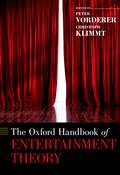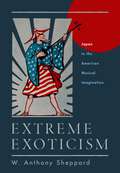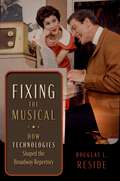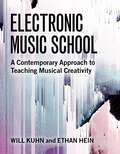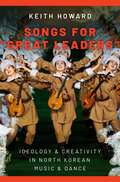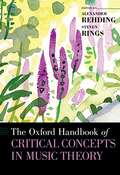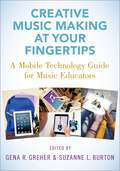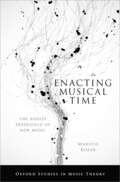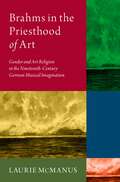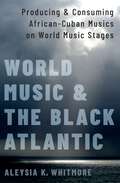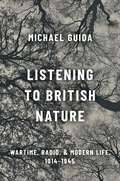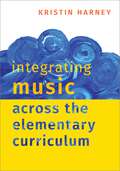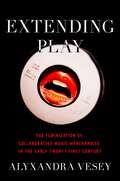- Table View
- List View
The Oxford Handbook of Entertainment Theory (Oxford Handbooks)
by Christoph Klimmt Peter VordererThe proliferation of new digital technologies has given rise to an entirely changed media landscape and revolutionized how we seek entertainment. Older entertainment media like novels, radio, and film have been joined by a host of digital media that smartphones allow us to carry almost anywhere and at all times, from video games and social media to video on demand services. This unprecedented ubiquity of entertainment media calls for new and more sophisticated theories that help us understand the fascination that different entertainment media exert on us and how they change the human experience. The Oxford Handbook of Entertainment Theory surveys and furthers the most influential psychology-driven research on media entertainment to illuminate how people are drawn into media experiences. The 41 chapters in this Handbook not only offer fresh perspectives on established theories but also introduce emerging models and highlight the importance of considering the diverse backgrounds of media users when conducting research. They also cover the motivations and reactions of media users in relationship to different types of media, the trend towards interactive media such as video games and virtual reality, and particularly popular media contents like sexuality, violence, sports, and the news. As the most comprehensive overview of psychology-based research on media entertainment available, this Handbook is an invaluable resource for seasoned researchers and those beginning to learn about the field alike.
Extreme Exoticism: Japan in the American Musical Imagination
by W. Anthony SheppardTo what extent can music be employed to shape one culture's understanding of another? In the American imagination, Japan has represented the "most alien" nation for over 150 years. This perceived difference has inspired fantasies--of both desire and repulsion--through which Japanese culture has profoundly impacted the arts and industry of the U.S. While the influence of Japan on American and European painting, architecture, design, theater, and literature has been celebrated in numerous books and exhibitions, the role of music has been virtually ignored until now. W. Anthony Sheppard's Extreme Exoticism offers a detailed documentation and wide-ranging investigation of music's role in shaping American perceptions of the Japanese, the influence of Japanese music on American composers, and the place of Japanese Americans in American musical life. Presenting numerous American encounters with and representations of Japanese music and Japan, this book reveals how music functions in exotic representation across a variety of genres and media, and how Japanese music has at various times served as a sign of modernist experimentation, a sounding board for defining American music, and a tool for reshaping conceptions of race and gender. From the Tin Pan Alley songs of the Russo-Japanese war period to Weezer's Pinkerton album, music has continued to inscribe Japan as the land of extreme exoticism.
Extreme Exoticism: Japan in the American Musical Imagination
by W. Anthony SheppardTo what extent can music be employed to shape one culture's understanding of another? In the American imagination, Japan has represented the "most alien" nation for over 150 years. This perceived difference has inspired fantasies--of both desire and repulsion--through which Japanese culture has profoundly impacted the arts and industry of the U.S. While the influence of Japan on American and European painting, architecture, design, theater, and literature has been celebrated in numerous books and exhibitions, the role of music has been virtually ignored until now. W. Anthony Sheppard's Extreme Exoticism offers a detailed documentation and wide-ranging investigation of music's role in shaping American perceptions of the Japanese, the influence of Japanese music on American composers, and the place of Japanese Americans in American musical life. Presenting numerous American encounters with and representations of Japanese music and Japan, this book reveals how music functions in exotic representation across a variety of genres and media, and how Japanese music has at various times served as a sign of modernist experimentation, a sounding board for defining American music, and a tool for reshaping conceptions of race and gender. From the Tin Pan Alley songs of the Russo-Japanese war period to Weezer's Pinkerton album, music has continued to inscribe Japan as the land of extreme exoticism.
Fixing the Musical: How Technologies Shaped the Broadway Repertory
by Douglas L. ResideThousands of shows have opened on Broadway. Why do we remember some and not others? The musical theatre repertory is not composed of titles popular in the theatre but by those with successful cast recordings, movie versions, or even illegal bootlegs on YouTube. The shows audiences know, and the texts and music they expect to hear when they attend a production, are defined by media consumed at home more than by memories of performances witnessed in the theatre. For example, author Doug Reside shows that it is no accident that the serious book musical with a fixed score developed in the 1940s - when commercially pressed and marketed record albums made it possible to record most of the score of a new musical in a fixed medium. And Hamilton, a musical with dense lyrics and revolutionary musical style, would not have been as easily accessible to world audiences if most hadn't already had the opportunity to learn the score by listening to free digital streams of the original cast recording. The technologies that made these media possible developed concurrently with and shaped the American musical as an art form. Reside uncovers how the affordances and limitations of these technologies established a repertory of titles that are most frequently performed and defined by the texts used in these performances. Fixing the Musical argues that the musicals we most remember are those which most effectively used their era's best recording and distribution technologies to document and share the work with those who would never see the original production on Broadway.
Fixing the Musical: How Technologies Shaped the Broadway Repertory
by Douglas L. ResideThousands of shows have opened on Broadway. Why do we remember some and not others? The musical theatre repertory is not composed of titles popular in the theatre but by those with successful cast recordings, movie versions, or even illegal bootlegs on YouTube. The shows audiences know, and the texts and music they expect to hear when they attend a production, are defined by media consumed at home more than by memories of performances witnessed in the theatre. For example, author Doug Reside shows that it is no accident that the serious book musical with a fixed score developed in the 1940s - when commercially pressed and marketed record albums made it possible to record most of the score of a new musical in a fixed medium. And Hamilton, a musical with dense lyrics and revolutionary musical style, would not have been as easily accessible to world audiences if most hadn't already had the opportunity to learn the score by listening to free digital streams of the original cast recording. The technologies that made these media possible developed concurrently with and shaped the American musical as an art form. Reside uncovers how the affordances and limitations of these technologies established a repertory of titles that are most frequently performed and defined by the texts used in these performances. Fixing the Musical argues that the musicals we most remember are those which most effectively used their era's best recording and distribution technologies to document and share the work with those who would never see the original production on Broadway.
Electronic Music School: A Contemporary Approach to Teaching Musical Creativity
by Will Kuhn Ethan HeinElectronic Music School: A Contemporary Approach to Teaching Musical Creativity is a practical blueprint for teachers wanting to begin teaching music technology to secondary age students. Will Kuhn and Ethan Hein inspire classroom music teachers to expand beyond traditional ensemble-based music education offerings to create a culture of unique creativity and inclusivity at their schools. Part One offers an overview of the philosophical and institutional aspects of starting a music technology program, with a particular focus on the culture of electronic music surrounding digital music creation tools. Part Two dives deep into curricula for music lab classes, including several lesson examples and techniques. This section also includes abbreviated project plans for teachers who have fewer contact hours with their students. Part Three discusses how music technology courses can grow into a larger media creation program, how such a program can contribute to the broader school culture, and how project-based music learning effectively prepares students for careers in media. Electronic Music School also includes narratives from music technology students themselves, who often have an intuitive understanding of the future directions music technology programs can take.
Electronic Music School: A Contemporary Approach to Teaching Musical Creativity
by Will Kuhn Ethan HeinElectronic Music School: A Contemporary Approach to Teaching Musical Creativity is a practical blueprint for teachers wanting to begin teaching music technology to secondary age students. Will Kuhn and Ethan Hein inspire classroom music teachers to expand beyond traditional ensemble-based music education offerings to create a culture of unique creativity and inclusivity at their schools. Part One offers an overview of the philosophical and institutional aspects of starting a music technology program, with a particular focus on the culture of electronic music surrounding digital music creation tools. Part Two dives deep into curricula for music lab classes, including several lesson examples and techniques. This section also includes abbreviated project plans for teachers who have fewer contact hours with their students. Part Three discusses how music technology courses can grow into a larger media creation program, how such a program can contribute to the broader school culture, and how project-based music learning effectively prepares students for careers in media. Electronic Music School also includes narratives from music technology students themselves, who often have an intuitive understanding of the future directions music technology programs can take.
Songs for "Great Leaders": Ideology and Creativity in North Korean Music and Dance
by Keith HowardFamously reclusive and secretive, North Korea can be seen as a theatre that projects itself through music and performance. The first book-length account of North Korean music and dance in any language other than Korean, Songs for "Great Leaders" pulls back the curtain on this theatre for the first time. Renowned ethnomusicologist Keith Howard moves from the first songs written in the northern part of the divided Korean peninsula in 1946 to the performances in February 2018 by a North Korean troupe visiting South Korea for the Pyeongchang Winter Olympic Games. Through an exceptionally wide range of sources and a perspective of deep cultural competence, Howard explores old revolutionary songs and new pop songs, developments of Korean instruments, the creation of revolutionary operas, and mass spectacles, as well as dance and dance notation, and composers and compositions. The result is a nuanced and detailed account of how song, together with other music and dance production, forms the soundtrack to the theater of daily life, embedding messages that tell the official history, the exploits of leaders, and the socialist utopia yet-to-come. Based on fieldwork, interviews, and resources in private and public archives and libraries in North Korea, South Korea, China, North America and Europe, Songs for "Great Leaders" opens up the North Korean regime in a way never before attempted or possible.
Songs for "Great Leaders": Ideology and Creativity in North Korean Music and Dance
by Keith HowardFamously reclusive and secretive, North Korea can be seen as a theatre that projects itself through music and performance. The first book-length account of North Korean music and dance in any language other than Korean, Songs for "Great Leaders" pulls back the curtain on this theatre for the first time. Renowned ethnomusicologist Keith Howard moves from the first songs written in the northern part of the divided Korean peninsula in 1946 to the performances in February 2018 by a North Korean troupe visiting South Korea for the Pyeongchang Winter Olympic Games. Through an exceptionally wide range of sources and a perspective of deep cultural competence, Howard explores old revolutionary songs and new pop songs, developments of Korean instruments, the creation of revolutionary operas, and mass spectacles, as well as dance and dance notation, and composers and compositions. The result is a nuanced and detailed account of how song, together with other music and dance production, forms the soundtrack to the theater of daily life, embedding messages that tell the official history, the exploits of leaders, and the socialist utopia yet-to-come. Based on fieldwork, interviews, and resources in private and public archives and libraries in North Korea, South Korea, China, North America and Europe, Songs for "Great Leaders" opens up the North Korean regime in a way never before attempted or possible.
The Oxford Handbook of Critical Concepts in Music Theory (Oxford Handbooks)
by Alexander Rehding and Steven RingsMusic Theory has a lot of ground to cover. Especially in introductory classes a whole range of fundamental concepts are introduced at fast pace that can never be explored in depth or detail, as other new topics become more pressing. The short time we spend with them in the classroom belies the complexity (and, in many cases, the contradictions) underlying these concepts. This book takes the time to tarry over these complexities, probe the philosophical assumptions on which these concepts rest, and shine a light on all their iridescent facets. This book presents music-theoretical concepts as a register of key terms progressing outwards from smallest detail to discussions of the music-theoretical project on the largest scale. The approaches individual authors take range from philosophical, historical, or analytical to systematic, cognitive, and critical-theorical-covering the whole diverse spectrum of contemporary music theory. In some cases authors explore concepts that have not yet been widely added to the theorist's toolkit but deserve to be included; in other cases concepts are expanded beyond their core repertory of application. This collection does not shy away from controversy. Taken in their entirety, the essays underline that music theory is on the move, exploring new questions, new repertories, and new approaches. This collection is an invitation to take stock of music theory in the early twenty-first century, to look back and to encourage discussion about its future directions. Its chapters open up a panoramic view of the contemporary music-theoretical landscape with its expanding repertories and changing guiding questions, and offers suggestions as to where music theory is headed in years to come.
Creative Music Making at Your Fingertips: A Mobile Technology Guide for Music Educators
Students are drawn to mobile technologies such as iPads and smartphones because of the sheer endless possibilities of the digital worlds they hold. But how can their potential for stimulating the imagination be effectively used in the music classroom to support students' development of musical thinking? Countering voices that see digital technologies as a threat to traditional forms of music making and music education, this collection explores the many ways in which hand-held devices can be used to promote student learning and provides teachers with guidance on making them a vital presence in their own classrooms. Creative Music Making at Your Fingertips features 11 chapters by music education scholars and practitioners that provide tried-and-true strategies for using mobile devices in a variety of contexts, from general music education to ensembles and from K-12 to college classrooms. Drawing on their own experiences with bringing mobile devices and different music apps into the classroom, contributors show how these technologies can be turned into tools for teaching performance, improvisation, and composition. Their practical advice on how pedagogy and mobile technologies can be aligned to increase students' creative engagement with music and help them realize their musical potential makes this book an invaluable resource for music educators who want to be at the forefront of pedagogical transformations made possible by 21st-century technologies.
CREAT MUSIC MAKING AT YOUR FINGERTIPS C: A Mobile Technology Guide for Music Educators
by Gena R. Greher, Suzanne L. BurtonStudents are drawn to mobile technologies such as iPads and smartphones because of the sheer endless possibilities of the digital worlds they hold. But how can their potential for stimulating the imagination be effectively used in the music classroom to support students' development of musical thinking? Countering voices that see digital technologies as a threat to traditional forms of music making and music education, this collection explores the many ways in which hand-held devices can be used to promote student learning and provides teachers with guidance on making them a vital presence in their own classrooms. Creative Music Making at Your Fingertips features 11 chapters by music education scholars and practitioners that provide tried-and-true strategies for using mobile devices in a variety of contexts, from general music education to ensembles and from K-12 to college classrooms. Drawing on their own experiences with bringing mobile devices and different music apps into the classroom, contributors show how these technologies can be turned into tools for teaching performance, improvisation, and composition. Their practical advice on how pedagogy and mobile technologies can be aligned to increase students' creative engagement with music and help them realize their musical potential makes this book an invaluable resource for music educators who want to be at the forefront of pedagogical transformations made possible by 21st-century technologies.
Enacting Musical Time: The Bodily Experience of New Music (Oxford Studies in Music Theory)
by Mariusz KozakWhat is musical time? Where is it manifested? How does it enter into our experience, and how do we capture it in our analyses? A compelling approach among works on temporality, phenomenology, and the ecologies of the new sound worlds, Enacting Musical Time argues that musical time is itself the site of the interaction between musical sounds and a situated, embodied listener, created by the moving bodies of participants engaged in musical activities. Author Mariusz Kozak describes musical time as something that emerges when the listener enacts her implicit knowledge about "how music goes," from deliberate inactivity, to such simple actions as tapping her foot in time with the beat, to dancing in a way that engages her entire body. Kozak explores this idea in the context of modernist and postmodernist musical styles, where composers create unfamiliar and idiosyncratic temporal experiences, blur the line between spectatorship and participation, and challenge conventional notions of form. Basing his discussion on the phenomenology of Merleau-Ponty and on the ecological psychology of J. J. Gibson, Kozak examines different aspects of musical structure through the lens of embodied cognition and what phenomenologists call "lived time." A bold new theory derived from an unprecedented fusion of research perspectives, Enacting Musical Time will engage scholars across a range of disciplines, from music theory, music cognition, cognitive science, continental philosophy, and social anthropology.
Enacting Musical Time: The Bodily Experience of New Music (Oxford Studies in Music Theory)
by Mariusz KozakWhat is musical time? Where is it manifested? How does it enter into our experience, and how do we capture it in our analyses? A compelling approach among works on temporality, phenomenology, and the ecologies of the new sound worlds, Enacting Musical Time argues that musical time is itself the site of the interaction between musical sounds and a situated, embodied listener, created by the moving bodies of participants engaged in musical activities. Author Mariusz Kozak describes musical time as something that emerges when the listener enacts her implicit knowledge about "how music goes," from deliberate inactivity, to such simple actions as tapping her foot in time with the beat, to dancing in a way that engages her entire body. Kozak explores this idea in the context of modernist and postmodernist musical styles, where composers create unfamiliar and idiosyncratic temporal experiences, blur the line between spectatorship and participation, and challenge conventional notions of form. Basing his discussion on the phenomenology of Merleau-Ponty and on the ecological psychology of J. J. Gibson, Kozak examines different aspects of musical structure through the lens of embodied cognition and what phenomenologists call "lived time." A bold new theory derived from an unprecedented fusion of research perspectives, Enacting Musical Time will engage scholars across a range of disciplines, from music theory, music cognition, cognitive science, continental philosophy, and social anthropology.
Brahms in the Priesthood of Art: Gender and Art Religion in the Nineteenth-Century German Musical Imagination
by Laurie McManusBrahms in the Priesthood of Art: Gender and Art Religion in the Nineteenth-Century German Musical Imagination explores the intersection of gender, art religion (Kunstreligion) and other aesthetic currents in Brahms reception of the nineteenth and early twentieth centuries. In particular, it focuses on the theme of the self-sacrificing musician devoted to his art, or "priest of music," with its quasi-mystical and German Romantic implications of purity seemingly at odds with the lived reality of Brahms's bourgeois existence. While such German Romantic notions of art religion informed the thinking on musical purity and performance, after the failed socio-political revolutions of 1848/49, and in the face of scientific developments, the very concept of musical priesthood was questioned as outmoded. Furthermore, its essential gender ambiguity, accommodating such performing mothers as Clara Schumann and Amalie Joachim, could suit the bachelor Brahms but leave the composer open to speculation. Supportive critics combined elements of masculine and feminine values with a muddled rhetoric of prophets, messiahs, martyrs, and other art-religious stereotypes to account for the special status of Brahms and his circle. Detractors tended to locate these stereotypes in a more modern, fin-de-siècle psychological framework that questioned the composer's physical and mental well-being. In analyzing these receptions side by side, this book revises the accepted image of Brahms, recovering lost ambiguities in his reception. It resituates him not only in a romanticized priesthood of art, but also within the cultural and gendered discourses overlooked by the absolute music paradigm.
Brahms in the Priesthood of Art: Gender and Art Religion in the Nineteenth-Century German Musical Imagination
by Laurie McManusBrahms in the Priesthood of Art: Gender and Art Religion in the Nineteenth-Century German Musical Imagination explores the intersection of gender, art religion (Kunstreligion) and other aesthetic currents in Brahms reception of the nineteenth and early twentieth centuries. In particular, it focuses on the theme of the self-sacrificing musician devoted to his art, or "priest of music," with its quasi-mystical and German Romantic implications of purity seemingly at odds with the lived reality of Brahms's bourgeois existence. While such German Romantic notions of art religion informed the thinking on musical purity and performance, after the failed socio-political revolutions of 1848/49, and in the face of scientific developments, the very concept of musical priesthood was questioned as outmoded. Furthermore, its essential gender ambiguity, accommodating such performing mothers as Clara Schumann and Amalie Joachim, could suit the bachelor Brahms but leave the composer open to speculation. Supportive critics combined elements of masculine and feminine values with a muddled rhetoric of prophets, messiahs, martyrs, and other art-religious stereotypes to account for the special status of Brahms and his circle. Detractors tended to locate these stereotypes in a more modern, fin-de-siècle psychological framework that questioned the composer's physical and mental well-being. In analyzing these receptions side by side, this book revises the accepted image of Brahms, recovering lost ambiguities in his reception. It resituates him not only in a romanticized priesthood of art, but also within the cultural and gendered discourses overlooked by the absolute music paradigm.
World Music and the Black Atlantic: Producing and Consuming African-Cuban Musics on World Music Stages
by Aleysia K. WhitmoreIn the mid-20th century, African musicians took up Cuban music as their own and claimed it as a marker of black Atlantic connections and of cosmopolitanism untethered from European colonial relations. Today, Cuban/African bands popular in Africa in the 1960s and '70s have moved into the world music scene in Europe and North America, and world music producers and musicians have created new West African-Latin American collaborations expressly for this market niche. World Music and the Black Atlantic follows two of these bands, Orchestra Baobab and AfroCubism, and the industry and audiences that surround them-from musicians' homes in West Africa, to performances in Europe and North America, to record label offices in London. World Music and the Black Atlantic examines the intensely transnational experiences of musicians, industry personnel, and audiences as they collaboratively produce, circulate, and consume music in a specific post-colonial era of globalization. Musicians, industry personnel, and audiences work with and push against one another as they engage in personal collaborations imbued with histories of global travel and trade. They move between and combine Cuban and Malian melodies, Norwegian and Senegalese markets, and histories of slavery and independence as they work together to create international commodities. Understanding the unstable and dynamic ways these peoples, musics, markets, and histories intersect elucidates how world music actors assert their places within, and produce knowledge about, global markets, colonial histories, and the black Atlantic. World Music and the Black Atlantic offers a nuanced view of a global industry that is informed and deeply marked by diverse transnational perspectives and histories of transatlantic exchange.
WORLD MUSIC & THE BLACK ATLANTIC C: Producing and Consuming African-Cuban Musics on World Music Stages
by Aleysia K. WhitmoreIn the mid-20th century, African musicians took up Cuban music as their own and claimed it as a marker of black Atlantic connections and of cosmopolitanism untethered from European colonial relations. Today, Cuban/African bands popular in Africa in the 1960s and '70s have moved into the world music scene in Europe and North America, and world music producers and musicians have created new West African-Latin American collaborations expressly for this market niche. World Music and the Black Atlantic follows two of these bands, Orchestra Baobab and AfroCubism, and the industry and audiences that surround them-from musicians' homes in West Africa, to performances in Europe and North America, to record label offices in London. World Music and the Black Atlantic examines the intensely transnational experiences of musicians, industry personnel, and audiences as they collaboratively produce, circulate, and consume music in a specific post-colonial era of globalization. Musicians, industry personnel, and audiences work with and push against one another as they engage in personal collaborations imbued with histories of global travel and trade. They move between and combine Cuban and Malian melodies, Norwegian and Senegalese markets, and histories of slavery and independence as they work together to create international commodities. Understanding the unstable and dynamic ways these peoples, musics, markets, and histories intersect elucidates how world music actors assert their places within, and produce knowledge about, global markets, colonial histories, and the black Atlantic. World Music and the Black Atlantic offers a nuanced view of a global industry that is informed and deeply marked by diverse transnational perspectives and histories of transatlantic exchange.
Journeys Through Galant Expositions
by L. Poundie BursteinEver since the nineteenth century, descriptions of musical form have tended to rely heavily on architectonic analogies. In contrast, earlier discussions more often invoked the metaphor of a journey to describe the structure of a composition. In Journeys Through Galant Expositions, author L. Poundie Burstein encourages readers to view the form of Galant music through this earlier metaphorical lens, much as those who composed, performed, improvised, and listened to music in the mid-1700s would have experienced it. By elucidating eighteenth-century ideas regarding musical form and applying them to works by a wide range of composers including Haydn and Mozart, as well as a host of others who are often overlooked this innovative study provides an accessible new window into the music of this time. Rather than dissecting concepts from the 1700s as a mere historical exercise or treating them as a precursor of later theories, Burstein invigorates the ideas of theorists such as Heinrich Christoph Koch and shows how they can directly impact our understanding and appreciation of Galant music as audiences and performers.
Journeys Through Galant Expositions
by L. Poundie BursteinEver since the nineteenth century, descriptions of musical form have tended to rely heavily on architectonic analogies. In contrast, earlier discussions more often invoked the metaphor of a journey to describe the structure of a composition. In Journeys Through Galant Expositions, author L. Poundie Burstein encourages readers to view the form of Galant music through this earlier metaphorical lens, much as those who composed, performed, improvised, and listened to music in the mid-1700s would have experienced it. By elucidating eighteenth-century ideas regarding musical form and applying them to works by a wide range of composers including Haydn and Mozart, as well as a host of others who are often overlooked this innovative study provides an accessible new window into the music of this time. Rather than dissecting concepts from the 1700s as a mere historical exercise or treating them as a precursor of later theories, Burstein invigorates the ideas of theorists such as Heinrich Christoph Koch and shows how they can directly impact our understanding and appreciation of Galant music as audiences and performers.
Listening to British Nature: Wartime, Radio, and Modern Life, 1914-1945
by Michael GuidaListening to British Nature: Wartime, Radio, and Modern Life, 1914-1945 reveals for the first time how the sounds and rhythms of the natural world were listened to, interpreted and used amid the pressures of early twentieth century life. The book argues that despite and sometimes because of the chaos of wartime and the struggle to recover, nature's voices were drawn close to provide security and engender optimism. Nature's sonic presences were not obliterated by machine age noise, the advent of radio broadcasting or the rush of the urban everyday, rather they came to complement and provide alternatives to modern modes of living. This book examines how trench warfare demanded the creation of new listening cultures to understand danger and to imagine survival. It tells of the therapeutic communities who made use of nature's quietude and the rhythms of rural work to restore shell-shocked soldiers, and of ramblers who sought to immerse themselves in the sensualities of the outdoors. It reveals how home-front listening during the Blitz was punctuated by birdsong, broadcast by the BBC. To listen to nature during this period was to cultivate an intimate connection with its energies and to sense an enduring order and beauty that could be taken into the future. Listening to nature was a way of being modern.
Listening to British Nature: Wartime, Radio, and Modern Life, 1914-1945
by Michael GuidaListening to British Nature: Wartime, Radio, and Modern Life, 1914-1945 reveals for the first time how the sounds and rhythms of the natural world were listened to, interpreted and used amid the pressures of early twentieth century life. The book argues that despite and sometimes because of the chaos of wartime and the struggle to recover, nature's voices were drawn close to provide security and engender optimism. Nature's sonic presences were not obliterated by machine age noise, the advent of radio broadcasting or the rush of the urban everyday, rather they came to complement and provide alternatives to modern modes of living. This book examines how trench warfare demanded the creation of new listening cultures to understand danger and to imagine survival. It tells of the therapeutic communities who made use of nature's quietude and the rhythms of rural work to restore shell-shocked soldiers, and of ramblers who sought to immerse themselves in the sensualities of the outdoors. It reveals how home-front listening during the Blitz was punctuated by birdsong, broadcast by the BBC. To listen to nature during this period was to cultivate an intimate connection with its energies and to sense an enduring order and beauty that could be taken into the future. Listening to nature was a way of being modern.
Integrating Music Across the Elementary Curriculum
by Kristin HarneyThis book is designed to support K-5 classroom teachers as they integrate music throughout the elementary curriculum. It contains detailed, practical ideas and examples, including full lesson plans and over 100 teaching ideas and strategies for integrating music with visual art, language arts, social studies, science, and mathematics. Following an overview of the interdisciplinary approach, the remaining chapters explore connections between music and other areas of the elementary curriculum. Each chapter also includes a section addressing national standards with tables showing the specific standards that are included in each lesson and activity. This text utilizes the most recent National Core Arts Standards (2015) as well as the most recent standards in mathematics, science, social studies, and language arts. All the lessons in this book are designed to be fully taught by classroom teachers; the content is accessible to those who lack formal music training, yet is solidly rooted in research and best practices. While classroom teachers can teach these lessons on their own, this book may facilitate partnerships and collaboration between classroom teachers and music specialists. All the lessons and activities included in this text have been reviewed by practicing teachers and most have been field tested in elementary classrooms. Throughout the book, there is an emphasis on interdisciplinary lessons that demonstrate valid connections between disciplines while maintaining the integrity of each discipline involved, including a teacher-tested model that allows teachers to successfully create their own interdisciplinary lessons.
Integrating Music Across the Elementary Curriculum
by Kristin HarneyThis book is designed to support K-5 classroom teachers as they integrate music throughout the elementary curriculum. It contains detailed, practical ideas and examples, including full lesson plans and over 100 teaching ideas and strategies for integrating music with visual art, language arts, social studies, science, and mathematics. Following an overview of the interdisciplinary approach, the remaining chapters explore connections between music and other areas of the elementary curriculum. Each chapter also includes a section addressing national standards with tables showing the specific standards that are included in each lesson and activity. This text utilizes the most recent National Core Arts Standards (2015) as well as the most recent standards in mathematics, science, social studies, and language arts. All the lessons in this book are designed to be fully taught by classroom teachers; the content is accessible to those who lack formal music training, yet is solidly rooted in research and best practices. While classroom teachers can teach these lessons on their own, this book may facilitate partnerships and collaboration between classroom teachers and music specialists. All the lessons and activities included in this text have been reviewed by practicing teachers and most have been field tested in elementary classrooms. Throughout the book, there is an emphasis on interdisciplinary lessons that demonstrate valid connections between disciplines while maintaining the integrity of each discipline involved, including a teacher-tested model that allows teachers to successfully create their own interdisciplinary lessons.
Extending Play: The Feminization of Collaborative Music Merchandise in the Early Twenty-First Century
by Alyxandra VeseyDespite the hypervisibility of a constellation of female pop stars, the music business is structured around gender inequality. As a result, women in the music industry often seize on self-branding opportunities in fashion, cosmetics, food, and technology for the purposes of professional longevity. Extending Play examines the ubiquity of brand partnerships in the contemporary music industry through the lens of feminized labor, to demonstrate how female artists use them as a resource for artistic expression and to articulate forms of popular feminism through self-commodification. In this book, author Alyxandra Vesey examines this type of promotional work and examines its proliferation in the early 21st century. Though brand partnerships exist across all media industries, they are a distinct phenomenon for the music business because of their associations with fan club merchandise, concert merchandise, and lifestyle branding, often foregrounding women's participation in shaping these economies through fan labor and image management. Through textual and discourse analysis of artists' songs, music videos, interviews, social media usage, promotional campaigns, marketing strategies, and business decisions, Extending Play investigates how female musicians co-create branded feminine-coded products like perfume, clothes, makeup, and cookbooks and masculine-coded products like music equipment as resources to work through their own ideas about gender and femininity as workers in industries that often use sexism and ageism to diminish women's creative authority and diminish the value of the recording in order to incentivize musicians to internalize the demands of industrial convergence. By merging star studies, popular music studies, and media industry studies, Extending Play proposes an integrated methodology for approaching contemporary cultural history that demonstrates how female-identified musicians have operated as both a hub for industrial convergence and as music industry professionals who use their extramusical skills to reassert their creative acumen.
